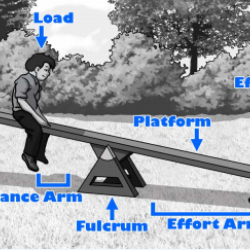Source Institutions
Source Institutions
Add to list Go to activity
Activity link broken? See if it's at the internet archive

In this activity, learners consider how a simple machine, a lever, turns a small push or pull (a small force) into a larger--or stronger--push or pull (a larger force). Learners then apply this concept to designing a model seesaw. In small groups, they explore a variety of materials in an open-ended process of building, testing, and revising. The challenge is set in an age-appropriate context of addressing one or more real-world challenges, such as designing a seesaw on which two people of different weights (e.g., a child and parent) or a person using a wheelchair can ride. This activity is part of a curriculum designed to engage learners in hands-on engineering challenges.
- 10 to 30 minutes
- 10 to 30 minutes
- Over $20 per group of students
- Ages 4 - 11
- Activity, Lesson/Lesson Plan, Model
- English
Quick Guide
Materials List (per group of students)
- A writing surface where the groups may sketch and write (optional)
- 10 small, relatively heavy objects, such as weights, pennies, metal washers, small rocks, or dried beans
- 2-3 LEGO® people (optional)
- A selection of long, thin, flat boards such as rulers, paint stirrers, popsicle sticks, large craft sticks, yardsticks
- A selection of cylinders such as soup cans, paper-towel tubes, dowels, ribbon and thread spools, markers, pencils, triangular blocks
- 2 small paper cups (such as 3-oz. Dixie® bath cups)
- 3 adhesive labels (preprinted with the terms "load," "fulcrum," and "effort") and a bean-bag chair or other fairly heavy object (optional)
- broom or long, flat board (optional)
- 1 (8½" × 11") Be Creative…Be an Engineer! poster (for tweens, teens, and adult helpers)
- A selection of adhesives: 3 or more rolls of masking tape, 3 packages of putty adhesive, such as Sticky Tack, and 1 (½" size, 200-ct.) roll of Glue Dots®
Subjects
-
Engineering and Technology
-
Engineering
- Mechanical Engineering
-
Engineering
-
Physical Sciences
-
Motion and Forces
- Machines
- Gravity
-
Motion and Forces
-
The Nature of Science
-
The Scientific Process
- About Inquiry
- Asking Questions
- Conducting Investigations
- Science as a Career
-
The Scientific Process
-
The Nature of Technology
-
The Design Process
- Research and Development
- Invention and Innovation
- Problem Solving
- Troubleshooting and Maintenance
-
The Design Process
Informal Categories
- Literature
- Model Building
- Toys
Audience
To use this activity, learners need to:
- see
- touch
Learning styles supported:
- Involves teamwork and communication skills
- Links STEM to other topics of interest such as arts and humanities
- Involves hands-on or lab activities
Other
Components that are part of this resource:
Includes alignment to state and/or national standards:
This resource is part of:
Access Rights:
- Free access
By:
- Department of Education and Public Outreach, Lunar and Planetary Institute; STAR Library Education Network
Rights:
Funding Source:
- NSF, DRL-1010844
